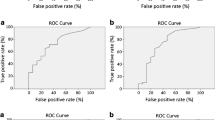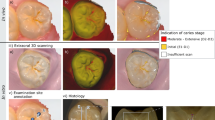Abstract
The aim of this study was firstly to assess inter- and intra- examiner reproducibility and accuracy in the detection of occlusal caries in extracted human teeth using the newly developed fluorescence-based camera VistaCam iX and secondly to compare the performance to the established fluorescence device VistaProof. The occlusal surfaces of 101 teeth were assessed. The distribution of the lesions were characterized first visually using ICDAS-II (consensus score). The investigation sites were assessed by two examiners with different levels of experience in cariology (one experienced dentist, one final-year dental student) by both fluorescence-based cameras VistaCam iX (FC1) and VistaProof (FC2). The teeth were hemisectioned and assessed for lesion depth. Intra-class-correlation coefficients for inter- and intra-examiner reproducibility were 0.88–0.97 (FC1) and 0.82–0.98 (FC2), respectively. There was significant positive correlation (r s, p < 0.01) between all methods (ICDAS-II, fluorescence, and histological examinations: 0.63–0.89) and between FC1 and FC2 (r s 0.85–0.90), respectively. Areas under the ROC curves (AUC) were 0.87–0.92 (D1 and D3 diagnostic threshold, FC1) and 0.91–0.96 (FC2). There were no significant differences between the AUC of both fluorescence cameras (p values > 0.05). Both fluorescence cameras demonstrated high reproducibility and good performance for the detection of occlusal caries at various stages of the disease process. The novice and the experienced examiner were able to apply both systems for detection of lesions. The in vitro performance of both devices was comparable to each other, although there was a tendency of a better performance for the FC2. Thus, within the limitations of an in vitro study, measurements with the FC2 can be continued by the new fluorescence camera (FC1) and data formerly assessed can be compared without significant loss of information.





Similar content being viewed by others
References
Pitts N (2004) “ICDAS”—an international system for caries detection and assessment being developed to facilitate caries epidemiology, research and appropriate clinical management. Community Dent Health 21:193–198
Jablonski-Momeni A, Stachniss V, Ricketts DNJ, Heinzel-Gutenbrunner M, Pieper K (2008) Reproducibility and accuracy of the ICDAS-II for detection of occlusal caries in vitro. Caries Res 42:79–87
International Caries Detection and Assessment System (ICDAS) Coordinating Committee. Criteria Manual. 2009. (http://www.icdas.org). Accessed 10 Dec 2011
Hibst R, Paulus R, Lussi A (2001) Detection of occlusal caries by laser fluorescence: basic and clinical investigations. Med Laser Appl 16:205–213
Rodrigues JA, Hug I, Neuhaus KW, Lussi A (2011) Light-emitting diode and laser fluorescence-based devices in detecting occlusal caries. J Biomed Opt 16:107003
Pretty IA (2006) Caries detection and diagnosis: novel technologies. J Dent 34:727–739
Thoms M (2006) Detection of intraoral lesions using a fluorescence camera. Proc SPIE Lasers Dent XII 6137:1–7
Rodrigues JA, Hug I, Diniz MB, Lussi A (2008) Performance of fluorescence methods, radiographic examination and ICDAS II on occlusal surfaces in vitro. Caries Res 42:297–304
De Benedetto MS, Morais CC, Novaes TF, de Almeida RJ, Braga MM, Mendes FM (2010) Comparing the reliability of a new fluorescence camera with conventional laser fluorescence devices in detecting caries lesions in occlusal and smooth surfaces of primary teeth. Lasers Med Sci 26:157–162
Jablonski-Momeni A, Schipper HM, Rosen SM, Heinzel-Gutenbrunner M, Roggendorf MJ, Stoll R, Stachniss V, Pieper K (2011) Performance of a fluorescence camera for detection of occlusal caries in vitro. Odontology 99:55–61
Jablonski-Momeni A, Rosen SM, Schipper HM, Stoll R, Roggendorf MJ, Heinzel-Gutenbrunner M, Stachniss V, Pieper K (2012) Impact of measuring multiple or single occlusal lesions on estimates of diagnostic accuracy using fluorescence methods. Lasers Med Sci 27:343–352
Jablonski-Momeni A, Ricketts DNJ, Weber K, Ziomek O, Heinzel-Gutenbrunner M, Schipper HM, Stoll R, Pieper K (2010) Effect of different time intervals between examinations on the reproducibility of ICDAS-II for occlusal caries. Caries Res 44:267–271
Jablonski-Momeni A, Ricketts DN, Stachniss V, Maschka R, Heinzel-Gutenbrunner M, Pieper K (2009) Occlusal caries: evaluation of direct microscopy versus digital imaging used for two histological classification systems. J Dent 37:204–211
Downer MC (1975) Concurrent validity of an epidemiological diagnostic system for caries with the histological appearance of extracted teeth as validating criterion. Caries Res 9:231–246
Bland JM, Altman DG (1986) Statistical methods for assessing agreement between two methods of clinical measurement. Lancet 327:307–310
Cohen J (1988) Statistical power analysis for the behavioural sciences, 2nd edn. Lawrence Erlbaum Assoc Inc., Hillsdale
Tape TG. Interpreting Diagnostic Tests. University of Nebraska Medical Center. http://gim.unmc.edu/dxtests/. Accessed 12 Feb 2012
Hanley JA, McNeil BJ (1983) A method of comparing the areas under receiver operating characteristic curves derived from the same cases. Radiology 148:839–843
Aktan AM, Cebe MA, Ciftçi ME, Sirin Karaarslan E (2011) A novel LED-based device for occlusal caries detection. Lasers Med Sci. doi:10.1007/s10103-011-1020-0
Pretty IA, Maupomé G (2004) A closer look at diagnosis in clinical dental practice. Part 5. Emerging technologies for caries detection and diagnosis. J Can Dent Assoc 70:540, 540a–i
Tranaeus S, Shi XQ, Lindgren LE, Trollsås K, Angmar-Månsson B (2002) In vivo repeatability and reproducibility of the quantitative light-induced fluorescence method. Caries Res 36:3–9
Pretty IA, Hall AF, Smith PW, Edgar WM, Higham SM (2002) The intra- and inter-examiner reliability of quantitative light-induced fluorescence (QLF) analyses. Br Dent J 193:105–109
Bland JM, Altman DG (1999) Measuring agreement in method comparison Studies. Stat Methods Med Res 8:135–160
Jablonski-Momeni A, Ricketts DNJ, Rolfsen S, Stoll R, Heinzel-Gutenbrunner M, Stachniss V, Pieper K (2011) Performance of laser fluorescence at tooth surface and histological section. Lasers Med Sci 26:171–178
Francescut P, Zimmerli B, Lussi A (2006) Influence of different storage methods on laser fluorescence values: a two-year study. Caries Res 40:181–185
Acknowledgment
The device VistaCam iX was provided by Dürr Dental, Bietigheim-Bissingen, Germany. The company had no role in the study design, data collection and analysis, or the preparation of the manuscript.
Author information
Authors and Affiliations
Corresponding author
Rights and permissions
About this article
Cite this article
Jablonski-Momeni, A., Liebegall, F., Stoll, R. et al. Performance of a new fluorescence camera for detection of occlusal caries in vitro. Lasers Med Sci 28, 101–109 (2013). https://doi.org/10.1007/s10103-012-1080-9
Received:
Accepted:
Published:
Issue Date:
DOI: https://doi.org/10.1007/s10103-012-1080-9




